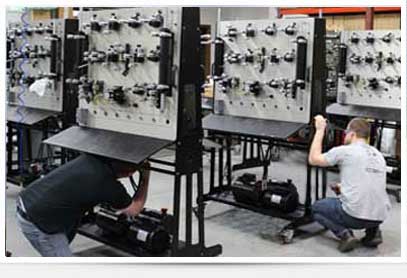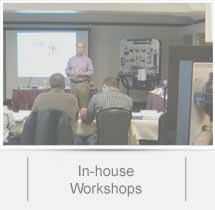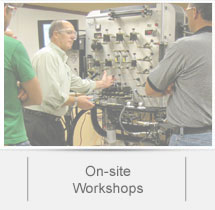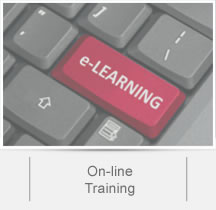Troubleshooting Hydraulics 5-day Workshop - $2,395.00
See here for PAYMENT and CANCELLATION POLICY information ->
Download Registration Form ->
2025 DATES -
(Workshops
sell out quickly so register EARLY!)
Salt Lake City, UTAH - May 5 to May 9, 2025
FPTI™’s hands-on troubleshooting workshop is, without a doubt, the most effective hydraulic troubleshooting workshop in the world. Why? Because your instructor, Rory S. McLaren, invented MicroLeak testing technology. Let Rory show you how to test 95% of the components in any hydraulic system – mobile or industrial – with the power unit safely locked out.
“Today I paid for my tuition and snazzy new tools in one hour. Cavitation caused by a hair line fracture in a(n) intake fitting feeding two pumps . Had all the symptoms, (k)new it was there just had to find it. Thanks Rory.”
– Satisfied student
“We took Rory to task and calculated the savings in unnecessary component replacement because our maintenance personnel could not performance test every hydraulic component in our sawmill. Rory’s guarantee of 75% is apparently very conservative, because we realized a cost reduction of 90%. Our calculations did not take into account additional savings in labor and production.”
– Maintenance Supervisor - MacMillan Bloedel - BC, Canada
Overview:
To develop the best troubleshooting workshop on the planet, we first identified the skillsets that determine a brilliant fluid power technician, and then we developed a workshop that teaches ordinary technicians how to be extraordinary hydraulic technicians. There is no hydraulic workshop in the country that will teach you more about safe and effective hydraulic component performance test techniques than this one.
Safety:
FPTI™ is the undisputed leader in hydraulic safety. In fact, Mary Gannon, Senior Associate Editor of Hydraulics & Pneumatics, the leading hydraulic publication in the US, said in a recent article, “I have never met anyone as passionate as Rory when it comes to training and safety in fluid power. He is perhaps one of the most vocal advocates of proper training for individuals who use fluid power.”
Simulators:
You will be learning on the most advanced hydraulic training systems in the world – the MF102’s designed and built by FPTI™. These training systems are so advanced that they have onboard computers that can automatically generate faults in any hydraulic system that are identical to the faults you will find in the real world.
Professionalism:
You will not be working on simulators without safety glasses. You will never see an instructor without safety glasses. We will not tell you that discharging high-pressure oil to atmosphere is dangerous, and then tell you to remove a transmission line from a pump or cylinder to perform a test. Our brilliant workshops will teach you how to think safety and work safely. In addition, you will learn how to scientifically document every components test like a true professional.
This is what you will learn hands-on in this amazing workshop:
1. How to test the inlet side of a hydraulic pump -Over 95% of open-loop pump failures are contributed to, or caused by, cavitation. You will learn everything there is to know about how the inlet side of a hydraulic pump functions and the cause and effect of cavitation with a completely transparent, fully-functional training simulator.
2. How to test the performance of a hydraulic pump -You will learn:
- That there is only one performance test for every type of hydraulic pump.
- How to properly test pumps under any conditions – when the machine can run load cycle, and when the machine cannot run load cycle.
- How to compose a pump performance test graph, and how to use it to plot a pump performance test.
- Why case flow pump testing is unreliable.
- Why pump manufacturers and their users are dead wrong when they tell you to test pumps to atmosphere.
- How to use state-of-the-art diagnostic instruments for testing hydraulic pumps.
- Why you must check five operating parameters when performance testing a hydraulic pump to avoid a false positive.
- What pump repair centers don’t know about pump testing that will have you very frustrated and cause you to loose a great deal of money.
- Symptoms associated with pump wear.
You will learn:
- Why the case pressure test given by most machinery and equipment manufacturers is incorrect.
- How to correctly check pump case pressure.
- Why it is imperative to run load cycles when testing pump case pressure.
- How and why design oversight causes pump seal problems.
- How to determine (without removing) which pump shaft seal is leaking in cases where there are two, or more, pumps mounted on a gearbox (hydraulic oil discharging from gearbox breather).
You will learn:
- How to test any type of pressure control valve for internal leakage in less than five minutes without removal or disassembly.
- How to perform a MicroLeak test on pressure relief valves, sequence valves, counterbalance valves, and differential pressure unloading valves.
- How to isolate a problem when a cartridge valve shares a cavity with a directional control valve. Use a MicroLeak Test to determine if the problem is the cartridge and/or the spool/bore without removal or disassembly.
- How to test a cross-port relief valve for internal leakage in less than five minutes without removal or disassembly.
You will learn:
- How to test a check valve for internal leakage in less than five minutes without removal or disassembly.
- How to test a pilot-to-open or pilot-to-close check valve in five minutes without removal or disassembly.
- Design over-sight that will cause cylinder drifting even when the circuit is equipped with a pilot-to-open check valve.
- How to pinpoint a leakage path in an application where a pilot-to-open check valve is integrated into a cylinder port without removal or disassembly.
You will learn:
- How to test a directional control valve for internal leakage in less than five minutes without removal or disassembly.
- How to pin-point a leakage path within a stacked valve assembly in less than five minutes without removal or disassembly.
- How to pinpoint a leakage path within a mobile directional control valve equipped with cylinder port relief valve and/or anti-cavitation valve in less than five minutes without removal or disassembly.
You will learn:
- How to test a hydraulic motor under any conditions without putting your hands/body in harm's way, i.e. rotating shafts, track drives, wheel drives, conveyor drives, etc.
- Why motor case flow testing is inaccurate.
- Why performing a “meter-out” motor “load” test is useless, and why it can cause a good motor to appear defective.
You will learn:
- How to test a cylinder, regardless of its size, while it is stationary – fully retracted or extended in the safe position (load/mechanism resting on the frame or ground). This test is especially useful for very large mining equipment.
- Why flow meters are generally not suitable or practical for testing hydraulic cylinders.
- How to perform a “through-stroke” test to determine if there is damage in a cylinder’s intermediate bore.
- How to isolate a leakage path when a hydraulic cylinder is equipped with integrated valves such as counterbalance or pilot-operated check.
What you will learn:
- How to isolate a problem within a shuttle network to determine if the problem is in the pump or in the load sense valve.
- How to performance test a load sense valve.
What you will learn:
- How to test the performance of an overcenter pump.
- How to test the performance of a charge pump.
- How to determine cause of overheating.
- How to determine cause of operation in one direction of travel only.
- How to determine cause of total system malfunction.
- How to determine cause of poor response.
- How to test pump and motor case pressure.
- Cause and effect of low charge pressure.
- Why charge pressures cannot be pre-set and must be set after pump and or motor installation.
- How to perform a post-catastrophic failure start-up procedure to insure zero transfer of contaminants.
What you will learn:
- How to test a hydraulic steering valve (orbitrol type) for internal leakage without removal or disassembly.
- Symptoms associated with wear in a hydraulic steering valve (orbitrol type).
NOTE: The simulators are uploaded with circuits from a variety of industrial and mobile machinery. Students will be working on actual hydraulics systems that are cycling under full-load conditions. The faults that the computer will introduce are identical to the faults found in the real world.
The primary objectives of the workshop are:
- Safety
- Develop critical thinking skills
- Learn how to test every type of hydraulic component in any type of system safely and effectively
If you have any questions regarding the course please contact the instructor directly. Send emails to forory@fpti.org
Hotel & Workshop Information ->


















